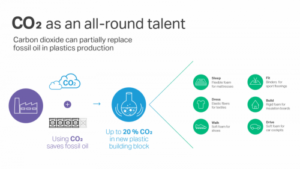Carbon dioxide instead of petroleum as a component in plastics – Covestro is pursuing new avenues for turning the waste gas into a useful raw material, expand the resource base of the chemicals industry and promote the circular economy. The company is working with partners on a number of projects for this purpose. Novel CO2 components are already available on the market for different types of plastic. The goal is to use carbon dioxide for as many applications as possible.
 Petroleum makes the world go round. The fossil resource fuels cars and airplanes, is the raw material for drugs and is found in almost all plastics. But petroleum reserves are limited. Something we have in abundance can be used in its place, however – carbon dioxide. This waste gas has one thing in common with petroleum: it contains the element carbon, a central building block for the chemical industry.
Petroleum makes the world go round. The fossil resource fuels cars and airplanes, is the raw material for drugs and is found in almost all plastics. But petroleum reserves are limited. Something we have in abundance can be used in its place, however – carbon dioxide. This waste gas has one thing in common with petroleum: it contains the element carbon, a central building block for the chemical industry.
The professional world has long dreamed of using CO2 as a raw material. Now that dream has come true: through an innovative technology that Covestro developed with partners from industry and science. It is now being used to produce a main component of plastic, called polyol. It is made up of 20 percent CO2 – meaning it can replace an equal amount of petroleum as conventional raw material.
Numerous applications
Covestro has been marketing the new material since 2016 under the name cardyon®. It is produced at the Dormagen site near Cologne, Germany in a purpose-built production facility that has an annual capacity of 5,000 metric tons. This CO2-based polyol is primarily used to manufacture soft polyurethane foam for mattresses and soft furniture – sleeping with CO2 technology.
Meanwhile, cardyon® is also used in sports – as a component of a new type of binder for sports underbodies. The novel material can also be found in shoe insoles as well as in components for car interiors such as armrests and headliners. In addition, the production of synthetic textile fibers with CO2 is close to market maturity. And in the future, houses may be fitted with CO2-based insulating panels to protect them against heat and cold.
Scientific breakthrough
Effective use of carbon dioxide as a raw material became possible once the right catalyst and the right processing technology had been found. This was the key because CO2, as an end product of combustion, is very slow to react. It first has to be “encouraged” to enter into a chemical bond. The experts had looked for catalyst and technology in vain for decades. Working in collaboration with the RWTH Aachen University and CAT Catalytic Center, Covestro researchers finally made the breakthrough.
Covestro has many more ideas for using carbon dioxide. The primary goal is to make intelligent use of carbon and dispense with petroleum in plastics production to the greatest extent possible. The company also wants to contribute to the circular economy by returning CO2 to the supply chain. In doing so, Covestro supports the United Nations Sustainable Development Goals (SDGs).









